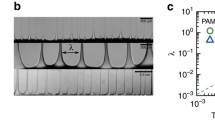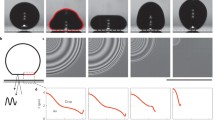Abstract
Film splitting necessarily occurs in roll coating and unwanted droplets can occur at high machine speeds when the resulting filaments break up. To study this ‘misting’ problem, an apparatus was designed and built to simulate filament fluid mechanics. The device creates a filament by elongating a liquid bridge and stretches the filament at a high and constant rate of acceleration to mimic coating machine kinematics. Filament breakup was observed using a high-speed video camera and the images were analyzed to yield droplet size and number. With Newtonian fluids, a single droplet formed at Ohnesorge (Oh) numbers less than 0.1 and more and smaller droplets were produced at Oh numbers above 0.1. Associative polymer solutions, prepared as weakly elastic fluids to represent industrial coatings, produced even more and smaller droplets, but only for Ohnesorge numbers in the range of 0.01 to 0.1.
















Similar content being viewed by others
References
Anna SL, McKinley GH (2001) Elastocapillary thinning and breakup of model elastic liquids. J Rheol 45:115–138
Anna SL, McKinley GH, Nguyen DA, Sridhar T, Muller SJ, Huang J, James DF (2001) An inter-laboratory comparison of measurements from filament-stretching rheometers using common test fluids. J Rheol 45:83–114
Ascanio G, Carreau PJ, Reglat O, Tanguy PA (2005) Extensional rheology of coating suspensions in relation with misting in film coaters. J Nordic Pulp Pap Res 20:48–52
Ercan SN, Bousfield DW (2001) Influence of fluid rheology on filament size. In: Int printing & graphic arts conference proc
Fernando RH, Xing L-L, Glass JE (2001) Erratum to “Rheology parameters controlling spray atomization and roll misting behavior of waterborne”. Prog Org Coat 42:284–288
Gron J (2000) Development of metered size press coating for high-speed operations. In: TAPPI metered size press symposium proc, p 241
Howard PR, Leasure EL, Rosier ST, Schaller EJ (1991) System approach to rheology control. In: Glass EJ (ed) Polymers as rheology modifiers, vol 462. ACS symposium, p 207
James DF, Yogachandran N (2006) Filament breaking length—a measure of elasticity in extension. Rheol Acta 46:161–170
James DF, Yogachandran N, Roper JA III (2003) Fluid elasticity measured by a new technique correlates with misting. In: TAPPI 8th advanced coating fundamentals symposium
Mannheimer R (1983) Rheological and mist ignition properties of dilute polymer solutions. Chem Eng Commun 19:221–341
Marmottant P, Villermaux E (2004) Fragmentation of stretched liquid ligaments. Phys Fluids 16:2732–2741
Notz PK, Chen AU, Basaran OA (2001) Satellite drops: unexpected dynamics and change of scaling during pinch-off. Phys Fluids 13:549–552
Pouran M (2006) Droplet formation and rheology in roll coating. PhD thesis, Dept Mech and Ind Eng, University of Toronto
Roper JA III, Urscheler R, Bousfield DW, Salminen P (1997) Observations and proposed mechanism of misting on high-speed metered size press coaters. In: TAPPI coating conference proc, pp 1–14
Sadeghy K, James DF (2000) Elasticity of associative polymer solutions and slip at high shear stress. J Non-Newton Fluid Mech 90:127–158
Salminen PJ, Roper JA III, Urscheler R, Chase D (1996) Optimizing the coating formulation to reduce misting in high-speed coating. In: TAPPI metered size press forum, pp 51–55
Smolinski JM, Gulari E, Manke CW (1996) Atomization of dilute polyisobutylene mineral oil solutions. AICHE J 42:1201–1212
Tirtaatmadja V, Sridhar T (1993) A filament stretching device for measurement of extensional viscosity. J Rheol 37:1081–1102
Zhang X, Padgett RS, Basaran OA (1996) Nonlinear deformation and breakup of stretching liquid bridges. J Fluid Mech 329:207–245
Acknowledgements
This study was a project within a Surface Science Consortium at the Pulp and Paper Centre at the University of Toronto and financial support from the consortium’s industrial sponsors is much appreciated. The authors are grateful to Salvatore Salpietro for his help in image analyses.
Author information
Authors and Affiliations
Corresponding author
Appendix
Appendix
The objective here is to find how filament velocity varies with time. As stated earlier, typically the paper speed is up to 1,500 m/min, the roll diameter is over 1 m, filaments break within the first 5 to 10° of rotation, and filament length at breakup is about 10 mm. Because of the latter factors, it is reasonable to assume that filaments are almost vertical at breakup. In Fig. 17, the rotation angle of the roller is labelled θ and the small angle between the filament and the vertical is α. The relevant trigonometric calculations are
Finding the components of velocity in the direction of the filament and in the direction perpendicular to the filament makes it possible to calculate the stretching velocity V E and the shearing velocity V S (Fig. 18):
and
where V is the paper speed. Because θ and α are small, V E ~Vθ, and V S is negligible by comparison. Furthermore, θ = Vt/R, where t is the time of stretching and R is the roll radius, so that \(V_{\rm E}=V^{2}t\)/R. Hence, it is found that a filament is stretched at a constant acceleration, equal to V 2/R. For the values given above for V (25 m/s) and R (0.5 m), the acceleration is about 1,000 m/s2.
Rights and permissions
About this article
Cite this article
James, D.F., Pouran, M. Droplet formation in quickly stretched liquid filaments. Rheol Acta 48, 611–624 (2009). https://doi.org/10.1007/s00397-009-0356-x
Received:
Revised:
Accepted:
Published:
Issue Date:
DOI: https://doi.org/10.1007/s00397-009-0356-x






